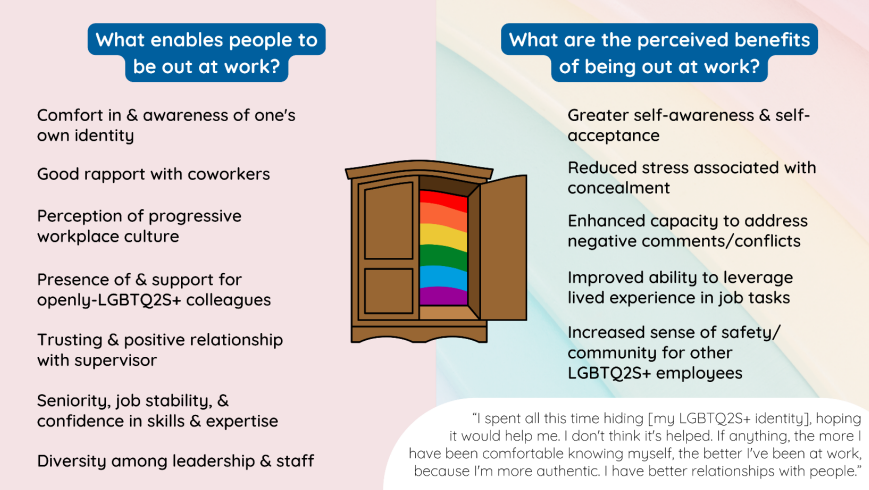Out and Safe
For generations, we have heard “live your best life,” “always tell the truth,” or “you won’t be happy if you don’t live your authentic life.” However, there is always a “but” for members of the 2SLGBTQIA+ communities. If we were to follow the “recommendations,” we would have to come out. But we would also encounter people saying we cannot show who we are and fully disclose our identities. It becomes an ongoing hide-and-seek game with no winner.

The coming out process is complex and could create unsafe situations. Many queer and trans professionals experience that in their lives, and the workplace is just another place for them to consider if, when, and how to disclose these aspects of their identities. It is essential to analyze multiple factors to come out, and employers are fully responsible for ensuring inclusive workplace practices if they are committed to bringing the best in their employees.
Coming out is an ongoing process as people base their interactions on assumptions. We, queer and trans folks, have different experiences sharing that ‘tiny’ piece of information about who we are, and no one has the right to out us in any circumstance. Our process considers assessing the environment, reading people in our surroundings to see if we can trust them, and even evaluating legal protection. Not everyone has a smooth start to their come-out, but we have learned to name the experienced discrimination.
Several research reports show violations of labour rights, wage gaps, microaggressions, harassment, and systemic barriers to being out at work. Although those discriminatory practices keep people away from their authentic selves in the workplace, many other 2SLGBTQIA+ professionals don’t want just to come out but to open up and start a conversation. They advocate for better working conditions and inclusive policies to make their peers comfortable while challenging discriminatory practices and behaviours from companies, leaders and colleagues.

For more nuanced examples of these experiences, please refer to: LGBTQ2S+ voices in employment: Labour market experiences of sexual and gender minorities in Canada (English) – SRDC.
If you are (representing) an employer, there are some actions you can take to support a more inclusive workplace. These recommendations will help you in your journey to create positive impacts on the experiences of queer and trans employees.
- evidence of commitment to 2SLGBTQIA+ employees at a systemic level and demonstration of accountability
- for example, demonstrated ethical use and actualization of employee feedback and data from internal diversity surveys while prioritizing confidentiality
- explicit policies, procedures, strategic directions, and action plans that include the protected grounds of gender expression, gender identity and sexual orientation
- for example, dress code policies should be based very specifically on safety related to the job, and inclusive options should be considered when not entirely removed. Dress codes have historically been how employers have penalized gender non-conforming, Black, Indigenous, and people from minority religions, including but not limited to Muslims and Sikhs
- meaningful relationships developed with 2SLGBTQIA+ communities
- representation of 2SLGBTQIA+ individuals in leadership
- evidence of ongoing commitment to learning
Be aware that we have always existed with our intersectional identities. If you assume that your workplace doesn’t have queer and trans people, rethink your policies because they might not be as inclusive as you thought. Also, having out staff and leadership isn’t indicative of Diversity, Equity and Inclusion, but it could demonstrate that you are in the right direction. You can engage and partner with more queer and trans communities and organizations to build trust for current and future employers.
Beyond celebrating National Coming Out Day, celebrate your commitment to cultivating a safer workplace, on clear anti-discrimination policies, educating all team members on 2SLGBTQIA+ inclusion, and becoming the best ally your employee could have. They flourish when they see themselves invited to be at the table and represented in non-tokenistic leadership roles. Ultimately, you need to take care of your garden to see bloom, how beautiful all your flowers are together, and attract birds and butterflies.
Resources:
- More than 50 percent of LGBTQ2S+ employees aren’t comfortable being out at work (English) – Xtra Magazine
- Coming Out Together campaign (English & French) – Egale
- Guide To Gender-Neutral Attire (English) – Indeed
- Creating Authentic Spaces: A Gender Identity and Gender Expression Toolkit (English & French) – The 519
- Our resources: Lead with Pride, Know Your Rights, and more (English & French) – Pride at Work Canada
